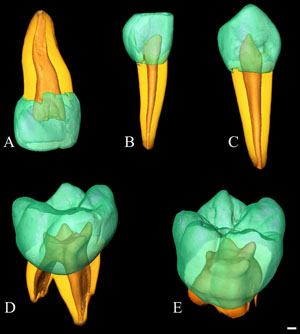It has long been the common perception that once modern humans appeared more than 50,000 years ago, little has changed in human biology.

Virtual 3D reconstruction of four deciduous and one permanent teeth assessed for linear, surface, and volumetric tissue proportions. A. deciduous upper right central incisor (Ui1, labial view); B. deciduous lower right lateral incisor (Li2, labial view); C. deciduous lower right canine (Lc, labial view); D. deciduous lower right second molar (Lm2, oblique mesio-buccal view); E. permanent lower right first molar (LM1, oblique mesio-buccal view). The volumes of the virtually reconstructed teeth are rendered in transparency and each tooth component (enamel cup, dentine, and pulp chamber) is shown in a different color. Scale bar is 1 mm.
As a result, in considerations of the biology of late archaic humans such as the Neandertals, it is common to compare them to living humans and largely ignore the biology of the early modern humans, the ones who were close in time to the Neandertals and other non-modern humans across the Old World.
In this context, an international team of researchers,* including Erik Trinkaus, Ph.D., professor of anthropology in Arts & Sciences at Washington University in St. Louis, has reanalyzed the complete immature dentition (comprising all of the deciduous and almost all of the permanent teeth) of a 30,000 year-old-child from the Abrigo do Lagar Velho, Portugal.
Their research was published the week of Jan. 4 in the Proceedings of the National Academy of Sciences.
The micro-tomographic (μCT) study of the dentition investigated the relative stages of formation of the developing teeth and the proportions of crown enamel, dentin and pulp in the teeth. The study documented that, for a given stage of development of the cheek teeth, the front teeth were relatively delayed in their degree of formation. The front teeth show a greater percentage of the total tooth volume with dentin and pulp, meaning the front teeth have proportionately less enamel than among recent humans. These patterns in the Lagar Velho dentition fit the pattern evident in the preceding Neandertals and they contrast with the ones known for later 12,000-year-old Pleistocene and living modern humans.
The new analysis of the Lagar Velho child thus joins a growing body of information, from other early modern human fossils in Europe (from Mladec in the Czech Republic, Pestera cu Oase and Pestera Muierii in Romania and Les Rois in France) which shows that these “early modern humans” were modern without being “fully modern,” Trinkaus said.
Human anatomical evolution continued after they lived 30,000 to 40,000 years ago.
For a Romanian translation of this release, go to webhostinggeeks.com/science/30000-year-rm.
* The team was led by Priscilla Bayle of the Muséum National d’Histoire Naturelle, France and Roberto Macchiarelli of the Université de Poitiers, France. It included Trinkaus, Cidália Duarte of Câmara Municipal do Porto, Portugal; Arnaud Mazurier of CRI-Biopôle-Poitiers, France; and João Zilhão of University of Bristol, United Kingdom.